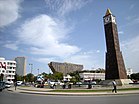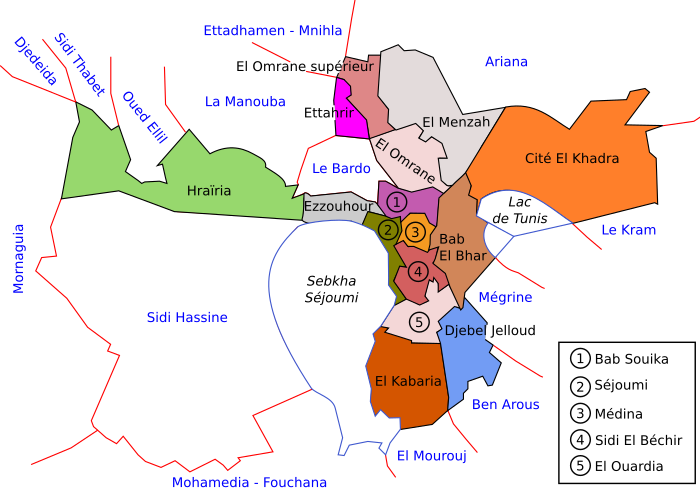Tunis
Tunis
تونس | ||
|---|---|---|
|
From top, left to right: Avenue Habib Bourguiba, Avenue 14 – Janvier 2011, the statue of Ibn Khaldoun, view of Tunis from Sidi Belhassen mountain, view of Sidi Bou Said , view of Tunis in Night. | ||
|
geoTLD .tn | | |
| Website | Official website | |
Tunis (
Situated on the Gulf of Tunis, behind the Lake of Tunis and the port of La Goulette (Ḥalq il-Wād), the city extends along the coastal plain and the hills that surround it. At its core lies the Medina, a World Heritage Site. East of the Medina, through the Sea Gate (also known as the Bab el Bhar and the Porte de France), begins the modern part of the city called "Ville Nouvelle", traversed by the grand Avenue Habib Bourguiba (often referred to by media and travel guides as "the Tunisian Champs-Élysées"), where the colonial-era buildings provide a clear contrast to smaller, older structures. Further east by the sea lie the suburbs of Carthage, La Marsa, and Sidi Bou Said.
As the capital of the country, Tunis is the focus of Tunisian political and administrative life and also the center of the country's commercial and cultural activities.
Etymology
Tunis is the transcription of the
Different explanations exist for the origin of the name Tunis. Some scholars relate it to the Carthaginian goddess Tanith ('Tanit or Tanut), as many ancient cities were named after patron deities.[2][3] Some scholars claim that it originated from Tynes, which was mentioned by Diodorus Siculus and Polybius in the course of descriptions of a location resembling present-day Al-Kasbah, Tunis's old Berber village.[4][5]
Another possibility is that it was derived from the Berber verbal root ens which means "to lie down" or "to pass the night".[6] The term Tunis can possibly mean "camp at night", "camp", or "stop", or may have referred to as "the last stop before Carthage" by people who were journeying to Carthage by land. There are also some mentions in ancient Roman sources of such names of nearby towns as Tuniza (now El Kala), Thunusuda (now Sidi-Meskin), Thinissut (now Bir Bouregba), and Thunisa (now Ras Jebel). As all of these Berber villages were situated on Roman roads, they undoubtedly served as rest-stations or stops.[7]
History
Carthage and early settlements
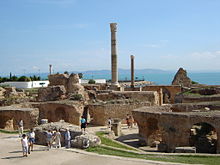
| UNESCO World Heritage Site | |
|---|---|
 | |
| Criteria | Cultural: ii, iii, vi |
| Reference | 37 |
| Inscription | 1979 (3rd Session) |
| Area | 616.02 ha |
The historical study of Carthage is problematic. Because its culture and records were destroyed by the Romans at the end of the
During the Mercenary War, it is possible that the town served as a center for the native population of the area,[13] and that its population was mainly composed of peasants, fishermen, and craftsmen. Compared to the ancient ruins of Carthage, the town's ancient ruins are not as large. According to Strabo, it was destroyed by the Romans in 146 BC during the Third Punic War. Both the town and Carthage were destroyed; the former, however, was rebuilt first[14] under the rule of Augustus and became an important town under Roman control and the center of a booming agricultural industry. The township is mentioned as Thuni in the Tabula Peutingeriana.[14] In the system of Roman roads for the Roman province of Africa, the town had the title of mutatio ("way station, resting place").[14] The borough, increasingly Romanized, was also eventually Christianized and became the seat of a bishop. However, it remained modestly sized compared to Carthage during this time.[15]
Foundation and early Islamic period
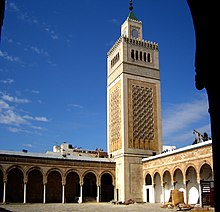
In the late 7th century, the Arab Muslims conquered the region, and in 698 a commune and a mosque were established at the outskirts of the ancient ruins, founded by
Local opposition to the authorities began to intensify in September 945, when
Exposed to violence from the hostile tribes that settled around the city, the population of Tunis repudiated the authority of the Zirids and swore allegiance to the
New capital of Tunisia
In 1159, the Almohad 'Abd al-Mu'min took Tunis, overthrew the last Khurasanid leader, and installed a new government in the kasbah of Tunis.[15] The Almohad conquest marked the beginning of the dominance of the city in Tunisia. Having previously played a minor role behind Kairouan and Mahdia, Tunis was promoted to the rank of provincial capital.
In 1228, Governor
During the Almohad and Hafsid periods, Tunis was one of the richest and grandest cities in the Islamic world, with a population of about 100,000.
During this period, one of the famous travelers to Tunis was Ibn Battuta. In his travel account, when Ibn Battuta and his group arrived in Tunis, the population of the city came out to meet him and the other members of his party. They all greeted them and were very curious, many were asking questions, however, no one in Tunis personally greeted Ibn Battuta, greatly upsetting him. He felt very lonely and could not hold back the tears coming from his eyes. This went on for a while until one of the pilgrims realized he was upset, he went up and greeted and talked to Ibn Battuta until he entered the city. At the time, the Sultan of Tunis was Abu Yahya and during Ibn Battuta's stay, the Festival of the Breaking of the Fast was taking place. The people in the city assembled in large numbers to celebrate the festival, in extravagant and most luxurious outfits. Abu Yahya arrived on horseback, where all of his relatives joined him. After the performance, the people returned to their homes.[20]
Spanish occupation and Ottoman control
The Ottoman Empire took nominal control of Tunis in 1534 when Hayreddin Barbarossa captured it from the Hafsid Sultan Mulai Hassan, who fled to the court of Charles V, Holy Roman Emperor and King of Spain. Charles, suffering losses from the corsairs operating out of Djerba, Tunis, and Algiers, agreed to reinstate Mulai Hassan in exchange for his acceptance of Spanish suzerainty. A naval expedition led by Charles himself was dispatched in 1535, and the city was recaptured. The victory against the corsairs is recorded in a tapestry at the Royal Palace of Madrid. The Spanish governor of La Goulette, Luys Peres Varga, fortified the island of Chikly in the lake of Tunis to strengthen the city's defenses between 1546 and 1550.
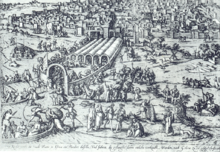
The Ottoman

In April 1655 the English admiral Robert Blake was sent to the Mediterranean to extract compensation from states that had been attacking English shipping. Only the Bey of Tunis refused to comply, with the result that Blake's fifteen ships attacked the Bey's arsenal at Porto Farina (Ghar el Melh), destroying nine Algerian ships and two shore batteries, the first time in naval warfare that shore batteries had been eliminated without landing men ashore.
At the beginning of the 18th century, Tunisia entered into a new period in its history with the advent of the Husainid dynasty. Successive Husainid rulers made great progress in developing the city and its buildings. During this period, the city prospered as a center of commerce. Taking advantage of divisions within the ruling house, Algerians captured Tunis in 1756 and put the country under supervision. Hammouda Bey faced bombardment by the Venetian fleet, and the city experienced a rebellion in 1811.[23] Under the reign of Hussein Bey II, naval defeats by the British (1826) and French (1827) saw the French become increasingly active in the city and in the economy.[24]
Various sources estimate the 19th-century population to have ranged from 90,000 to 110,000 inhabitants.[25] During the later 19th century, Tunis became increasingly populated by Europeans, particularly the French, and immigration dramatically increased the size of the city. This resulted in the first demolition of the old city walls, from 1860, to accommodate growth in the suburbs. The city spilled outside the area of the earlier town and the banks of the lake, and the new districts were modernized with running water (1860), lighting gas (1872), roads, waste collection (1873), and communication with adjacent suburbs and the city center.[26] The crafts and traditional trades declined somewhat, as the newcomers increased trade with Europe, introducing the first modern industries and new forms of urban life.
Development under the French protectorate


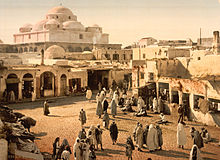
The creation of the French protectorate in 1881 was a turning point in Tunis's history, leading to rapid redevelopment of the city in the span of two to three decades. The city quickly spread out of its fortifications: it divided into a traditional Arab-populated old city, and a new city populated by immigrants, with a different structure from that of the traditional medina. Tunis also benefited from the French construction of a water supply, natural gas and electricity networks, public transport services, and other public infrastructure.
Under French rule, a substantial number of Europeans settled (like the
Tunis was quiet during the First World War. After the war, the city faced new transformations as the modern portion grew in importance and extended its network of boulevards and streets in all directions. In addition, a series of satellite cities emerged on the urban rim and encroached on the municipality of Tunis proper. In the economic sphere, commercial activities expanded and diversified as modern industries continued to grow, while traditional industry continued to decline.
During World War II, Tunis was held by Axis forces from November 1942 to May 1943. It was their last base in Africa, as they retreated towards Sicily after being surrounded by Allied forces from Algeria to the west and from Libya to the east.[28] On 7 May 1943, at about 15:30 in the afternoon, Tunis fell to troops of
Having succeeded in driving the Axis powers out of Tunisia, the Allies used Tunis as a base of operations from which to stage
Growth since independence
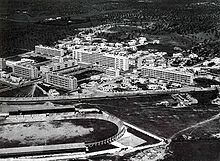
After independence in 1956, Tunis consolidated its role as the capital, first with the establishment of a constitution stating that the Chamber of Deputies and the Presidency of the Republic must have their headquarters in Tunis and its suburbs. In a very short time, the colonial city transformed rapidly. As the city has grown and native Tunisians gradually began to replace the extensive European population, the conflict between the Arab city and the European city has gradually decreased with the arabization of the population.
Because of population pressure and the rate of migration to the capital, the city continued to grow, even with the creation of new districts in the suburbs. Old buildings have gradually been renovated and upgraded. New buildings have come to influence the urban landscape. At the same time, an active policy of industrialization is developing the municipal economy.
The Arab League represents 22 Arab nations. It transferred its headquarters to Tunis in 1979 because of Egypt's peace with Israel. The Arab League returned to Egypt in 1990.
The Palestine Liberation Organization also had its headquarters in Tunis, from 1982[31] to 2003. In 1985, the PLO's headquarters was bombed by Israeli Air Force F-15s, killing approximately 60 people.
21st century
Many protests took place during the Arab Spring of 2011–12.
On 18 March 2015,
Geography
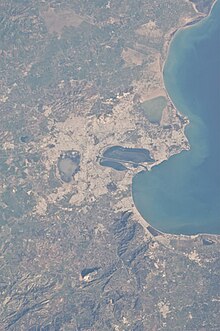
Tunis is located in north-eastern
The city of Tunis is built on a hill slope down to the lake of Tunis. These hills contain places such as Notre-Dame de Tunis, Ras Tabia, La Rabta, La Kasbah, Montfleury, and La Manoubia with altitudes just above 50 metres (160 feet).[36] The city is located at the crossroads of a narrow strip of land between Lake Tunis and Séjoumi. The isthmus between them is what geologists call the "Tunis dome", which includes hills of limestone and sediments. It forms a natural bridge and since ancient times several major roads linking to Egypt and elsewhere in Tunisia have branched out from it. The roads also connect with Carthage, emphasizing its political and economic importance not only in Tunisia but more widely in North Africa and the Mediterranean Sea in ancient times.
The Greater Tunis area has an area of 300,000 hectares (1,200 sq mi; 3,000 km2), 10% of which are urbanized, the rest being shared between bodies of water (20,000 hectares (77 sq mi; 200 km2) of lakes or lagoons) and agricultural or natural land (250,000 hectares (970 sq mi; 2,500 km2)). However, urban growth, which is estimated to be increasing by 500 hectares per year, is gradually changing the landscape with urban sprawl.
Suburbs
| Municipality | Population (2004) |
|---|---|
| Ettadhamen-Mnihla | 118,487 |
Ariana
|
97,687 |
| La Soukra | 89,151 |
| El Mourouj | 81,986 |
| La Marsa | 77,890 |
| Douar Hicher | 75,844 |
| Ben Arous | 74,932 |
| Mohamedia-Fouchana | 74,620 |
| Le Bardo | 70,244 |
| Le Kram | 58,152 |
| Oued Ellil | 47,614 |
| Radès | 44,857 |
| Raoued | 53,911 |
Hammam Lif
|
38,401 |
| La Goulette | 28,407 |
| Carthage | 28,407 |
La Manouba
|
26,666 |
| Mornag | 26,406 |
| Djedeida | 24,746 |
| Den Den | 24,732 |
| Tebourba | 24,175 |
| Mégrine | 24,031 |
| Kalâat el-Andalous | 15,313 |
| Mornaguia | 13,382 |
| Sidi Thabet | 8,909 |
Sidi Bou Saïd
|
4,793 |
| El Battan | 5,761 |
| Borj El Amri | 5,556 |
| Total | 1,265,060 |
| Sources: National Institute of Statistics[37] | |
After World War II, suburbs began to rapidly spring up on the outskirts of Tunis. These form a large percentage of the population of the Tunis metropolitan area. It grew from 27% of the total population in 1956, to 37% in 1975 and 50% in 2006.
Climate
Tunis has a hot-summer Mediterranean climate (Köppen climate classification Csa),[38] characterized by hot and dry, prolonged summers and mild winters with moderate rainfall. The local climate is also affected somewhat by the latitude of the city, the moderating influence of the Mediterranean sea, and the terrain of the hills.
Winter is the wettest season of the year, when more than a third of the annual rainfall falls during this period, raining on average every two or three days. The sun may still increase the temperature from 7 °C (45 °F) in the morning to 16 °C (61 °F) in the afternoon on average during the winter. Frosts are rare. The lowest temperature of −2.0 °C (28.4 °F) was recorded on 18 January 1979. In spring, rainfall declines by half. The sunshine becomes dominant in May when it reaches 10 hours a day on average. In March temperatures may vary between 8 °C (46 °F) and 18 °C (64 °F), and between 13 °C (55 °F) and 24 °C (75 °F) in May. However, it is common for temperatures to soar even as early as April with record temperatures reaching 40 °C (104 °F). In summer, rain is almost completely absent and the sunlight is at a maximum.
The average temperatures in the summer months of June, July, August, and September are very high. Sea breezes may mitigate the heat, but sometimes the sirocco winds reverse the trend. Occasional thunderstorms in the afternoon can develop quickly, especially after the periods of extremely hot weather. They usually do not produce precipitation (see dry thunderstorm), but may be accompanied by a brief shower. The highest temperature of 49.0 °C (120.2 °F) was recorded at Tunis-Carthage International Airport on July 24, 2023. In autumn, it begins to rain, often with short thunderstorms, which can sometimes cause flash floods or even flood some parts of the city.[39][40] The month of November marks a break in the general heat with average temperatures ranging from 11 °C (52 °F) to 20 °C (68 °F).
| Climate data for Tunis (Tunis–Carthage International Airport) 1991–2020, extremes 1943—present | |||||||||||||
|---|---|---|---|---|---|---|---|---|---|---|---|---|---|
| Month | Jan | Feb | Mar | Apr | May | Jun | Jul | Aug | Sep | Oct | Nov | Dec | Year |
| Record high °C (°F) | 25.6 (78.1) |
28.7 (83.7) |
36.5 (97.7) |
33.1 (91.6) |
41.4 (106.5) |
47.0 (116.6) |
49.0 (120.2) |
48.9 (120.0) |
44.4 (111.9) |
40.0 (104.0) |
34.5 (94.1) |
29.6 (85.3) |
49.0 (120.2) |
| Mean daily maximum °C (°F) | 15.7 (60.3) |
17.3 (63.1) |
20.1 (68.2) |
22.4 (72.3) |
25.1 (77.2) |
29.5 (85.1) |
33.0 (91.4) |
32.7 (90.9) |
25.2 (77.4) |
22.3 (72.1) |
19.8 (67.6) |
16.5 (61.7) |
25.2 (77.4) |
| Daily mean °C (°F) | 10.7 (51.3) |
12.1 (53.8) |
14.5 (58.1) |
16.6 (61.9) |
20.6 (69.1) |
24.2 (75.6) |
27.1 (80.8) |
26.3 (79.3) |
21.8 (71.2) |
20.5 (68.9) |
14.8 (58.6) |
11.8 (53.2) |
19.2 (66.6) |
| Mean daily minimum °C (°F) | 5.6 (42.1) |
6.8 (44.2) |
8.9 (48.0) |
10.8 (51.4) |
14.0 (57.2) |
17.9 (64.2) |
21.2 (70.2) |
21.7 (71.1) |
18.4 (65.1) |
14.6 (58.3) |
9.8 (49.6) |
7.0 (44.6) |
13.1 (55.6) |
| Record low °C (°F) | −5.3 (22.5) |
−2.6 (27.3) |
0.0 (32.0) |
1.7 (35.1) |
5.2 (41.4) |
10.6 (51.1) |
13.0 (55.4) |
11.7 (53.1) |
10.9 (51.6) |
5.6 (42.1) |
−1.1 (30.0) |
−0.1 (31.8) |
−5.3 (22.5) |
| Average precipitation mm (inches) | 73.0 (2.87) |
71.1 (2.80) |
72.6 (2.86) |
58.1 (2.29) |
27.2 (1.07) |
6.0 (0.24) |
2.1 (0.08) |
5.0 (0.20) |
19.9 (0.78) |
55.7 (2.19) |
79.2 (3.12) |
85.3 (3.36) |
555.2 (21.86) |
| Average precipitation days (≥ 1.0 mm) | 6.8 | 6.5 | 6.4 | 6.2 | 4.2 | 1.3 | 0.6 | 1.0 | 2.6 | 5.8 | 6.9 | 7.2 | 55.5 |
| Average relative humidity (%)
|
76 | 74 | 73 | 71 | 68 | 64 | 62 | 64 | 68 | 72 | 74 | 77 | 70 |
| Mean monthly sunshine hours | 145.7 | 159.6 | 198.4 | 225.0 | 282.1 | 309.0 | 356.5 | 328.6 | 258.0 | 217.0 | 174.0 | 148.8 | 2,802.7 |
| Mean daily sunshine hours | 4.7 | 5.7 | 6.4 | 7.5 | 9.1 | 10.3 | 11.5 | 10.6 | 8.6 | 7.0 | 5.8 | 4.8 | 7.7 |
| Source 1: Institut National de la Météorologie (precipitation days/humidity/sun 1961–1990)[41][42][43][note 1] | |||||||||||||
| Source 2: | |||||||||||||
Politics
Capital

Tunis has been the capital of Tunisia since 1159. Under Articles 43 and 24 of the
Municipality
Institutions
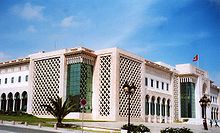

Following the municipal elections of 6 May 2018,
Before 2011, unlike other mayors in Tunisia, the mayor of Tunis was appointed by decree of the President of the Republic from among the members of the City Council.
Budget
The 2008 budget adopted by the City Council is structured as follows: 61.61 million dinars for operations and 32,516 million dinars for investment.[50] It reflects the improved financial situation of the municipality, the year 2007 was a year registering a surplus in resources that allowed the settlement of debts of the municipality and the strengthening of its credibility with respect its suppliers and public and private partners.
Revenues are generated by the proceeds of taxes on buildings and vacant lots, fees for the rental of municipal property, income from the operation of the public, advertising, and that the fact that the municipality has capital shares in some companies. On the expenditure side, provision is made for the consolidation of hygiene and cleanliness, the state of the environment and urban design, infrastructure maintenance, rehabilitation and renovation of facilities, and strengthening the logistics and means of work and transport.[50]
Administrative divisions
The city of Tunis, whose size has increased significantly during the second half of the 20th century, now extends beyond the Tunis Governorate into parts of the governorates of Ben Arous, Ariana and Manouba.
The municipality of Tunis is divided into 15 municipal districts:[51] These include El Bab Bhar, Bab Souika, Cité El Khadra, Jelloud Jebel El Kabaria, El Menzah, El Ouardia, Ettahrir, Ezzouhour, Hraïria, Medina, El Omrane, El Omrane Higher Séjoumi and Sidi El-Bashir.
Demography


| Year | Municipality | Metropolitan area |
|---|---|---|
| 1891 | 114,121 | |
| 1901 | 146,276 | |
| 1911 | 162,479 | |
| 1921 | 171,676 | 192,994 |
| 1926 | 185,996 | 210,240 |
| 1931 | 202,405 | 235,230 |
| 1936 | 219,578 | 258,113 |
| 1946 | 364,593 | 449,820 |
| 1956 | 410,000 | 561,117 |
| 1966 | 468,997 | 679,603 |
| 1975 | 550,404 | 873,515 |
| Sources: Sebag (1998) | ||
In the years following independence, the population of the metropolitan area continued to grow: by 21.1% from 1956 to 1966 and by 28.5% from 1966 to 1975 (55.6% between 1956 and 1975).[52] This steady growth was accompanied by changes that affected the nature of the settlement of the capital. Decolonization led to the exodus of some European minorities whose numbers dwindled every year. The gaps created by their departure were filled by Tunisians who emigrated to Tunis from other parts of the country.
The population of the city of Tunis exceeds 2,000,000 inhabitants. After independence, the Tunisian government implemented a plan to cope with the population growth of the city and country, a system of family planning, to attempt to lower the rate of population growth. However, between 1994 and 2004, the population of the governorate of Tunis grew more than 1.03% per annum. It represents, in the 2004 census, 9.9% of the total population of Tunisia.[53] As in the rest of Tunisia, literacy in the region of Tunis evolved rapidly during the second half of the 20th century and has reached a level slightly higher than the national average.[citation needed] The education level is only exceeded by the neighboring governorate of Ariana which has many institutions of education.
Economy
Parts of this article (those related to the city's economy) need to be updated. (August 2017) |
Overview


Products include textiles,
Because of the concentration of political authority (headquarters of the central government, presidency, parliament, ministries, and central government) and culture (festivals and mainstream media), Tunis is the only nationally ranking metropolis. Tunis is the heartland of the Tunisian economy and is the industrial and economic hub of the country, home to a third of Tunisian companies—including almost all the head offices of companies with more than fifty employees, with the exception of the
Tunis attracts foreign investors (33% of companies, 26% of investments and 27% of employment), excluding several areas due to economic imbalances. According to the Mercer 2017 Cost of Living Rankings, Tunis has the lowest cost of living for expatriates in the world.[55] The urban unemployment rate of university graduates is increasing and the illiteracy rate remains high among the elderly (27% of women and 12% of men).[54] The number of people living below the poverty line, falling at the national level, remains higher in urban areas. In addition, unemployment is high in young people aged 18 to 24, with one in three unemployed as compared to one in six at the national level. In Greater Tunis, the proportion of young unemployed is at 35%.[54]
Gulf finance house or GFH has invested $10 billion [citation needed] in order for the construction of Tunis financial harbor, which will transform Tunisia as the gateway to Africa from Europe. The project hopes to boost the economy of Tunisia as well as increase the number of tourists visiting Tunisia annually. The project is going through planning.
Sectors
The economic structure of Tunis, as well as that of the country, is overwhelmingly
Primary industry such as agriculture, however, is active in specialized agricultural areas in the suburbs, particularly in the wine and olive oil industries. The generally flat terrain and the two main rivers in Tunisia, the
Architecture and landscape
Urban landscape
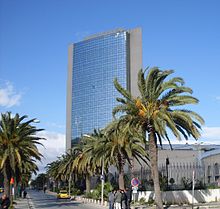


The Medina, built on a gentle hill slope on the way down to the Lake of Tunis, is the historical heart of the city and home to many monuments, including palaces, such as the Dar Ben Abdallah and Dar Hussein, the mausoleum of Tourbet el Bey and many mosques such as the Al-Zaytuna Mosque. Some of the fortifications around it have now largely disappeared, and it is flanked by the two suburbs of Bab Souika to the north and Bab El Jazira to the south. Located near the Bab Souika, the neighborhood of Halfaouine gained international attention through the film 'Halfaouine Child of the Terraces'.
But east of the original nucleus, first with the construction of the French Consulate, the modern city was built gradually with the introduction of the French protectorate at the end of the 19th century, on open land between the city and the lake. The axis to the structure of this part of the city is the Avenue Habib Bourguiba, designed by the French to be a Tunisian form of Champs-Élysées in Paris with its cafes, major hotels, shops, and cultural venues. On both sides of the tree lined avenue, north and south, the city was extended in various districts, with the northern end welcoming residential and business districts while the south receives industrial districts and poorer peoples.
South-east of the Avenue Bourguiba the district of La Petite Sicile (Little Sicily) is adjacent to the old port area and takes its name from its original population of workers from Italy. It is now the subject of a redevelopment project including the construction of twin towers. North of the Avenue Bourguiba is the district of La Fayette, which is still home to the Great Synagogue of Tunis and the Habib Thameur Gardens, built on the site of an ancient Jewish cemetery that lay outside the walls. Also to the north is the long Avenue Mohamed V, which leads to the Boulevard of 7 November through the neighborhood of the big banks where there are hotels and Abu Nawas Lake and finally to the Belvedere area around the place Pasteur. This is where the Belvedere Park lies, the largest in the city, and home to a zoo and the Pasteur Institute founded by Adrien Loir in 1893. Continuing to the north are the most exclusive neighborhoods of Mutuelleville which house the French Lycée Pierre-Mendès-France, the Sheraton Hotel, and some embassies.
Still further north of the Belvedere Park, behind the Boulevard of 7 November are the neighborhoods of
Southwest of the Medina, on the crest of the hills across the Isthmus of Tunis, is the Montfleury district then on down to the foothills of Séjoumi, the poor neighbourhood of
The south of Tunis is made up of disadvantaged neighbourhoods, especially due to the strong industry in this part of the metropolis. These include Jebel Jelloud, located in the southeast of Tunis, which concentrates on the heavy industry of cement production, the treatment plant of phosphate s, etc. The main cemetery in Tunis, the Djellaz Cemetery, dominates this part of town, perched on the slopes of a rocky outcrop.
Médina
| UNESCO World Heritage Site | |
|---|---|
 Roofs of the medina | |
| Criteria | Cultural: ii, iii, v |
| Reference | 36 |
| Inscription | 1979 (3rd Session) |
| Area | 296.41 ha |
| Buffer zone | 190.19 ha |


The
- The Aghlabid Al-Zaytouna Mosque ("Mosque of the Olive") built in 723 by Ubayd Allah ibn al-Habhab to celebrate the new capital.
- The Dar El Bey, or Bey's Palace, comprises architecture and decoration from many different styles and periods and is believed to stand on the remains of a Roman theatre as well as the 10th-century palace of Ziadib-Allah II al Aghlab.
With an area of 270 hectares (over 29 hectares for the Kasbah)[59] and more than 100,000 people, the Medina comprises one-tenth of the population of Tunis. The planning of the Medina of Tunis has the distinction of not grid lines or formal geometric compositions. However, studies were undertaken in the 1930s with the arrival of the first anthropologists who found that the space of the Medina is not random: the houses are based on a socio-cultural code according to the types of complex human relations.
Domestic architecture (palaces and townhouses), official and civilian (libraries and administrations), religious (mosques and zaouïas), and services (commercial and fondouks) are located in the Medina. The notion of public space is ambiguous in the case of Medina where the streets are seen as an extension of the houses and subject to social tags. The concept of ownership is low however and souks often spill out onto public roads. Today, each district has its culture, and rivalries can be strong.
The northern end supports the football club of
Founded in 698 is the
Furthermore, along the boulevards, the contribution of the architectural period 1850–1950 can be felt in the buildings, such as the government buildings of the nine ministries and the headquarters of the municipality of Tunis.
Other landmarks
- The Hafsid palace, located in the (then) suburbs of Tunis. It contains a major collection of Roman empires and other antiquities of interest from Ancient Greece, Tunisia, and the Arab period.
- The ruins of Carthage are nearby, along the coast to the northeast, with many ancient ruins.
Souks
The souks are a network of covered streets lined with shops and traders and artisans ordered by specialty.[61] Clothing merchants, perfumers, fruit sellers, booksellers, and wool merchants have goods at the souks, while fishmongers, blacksmiths, and potters tend to be relegated to the periphery of the markets.[61]

North of the Al-Zaytuna Mosque is the Souk El Attarine, built in the early 18th century. It is known for its essences and perfumes. From this souk, there is a street leading to the Souk Ech-Chaouachine (chachia). The main company that operates it is one of the oldest in the country and they are generally descendants of Andalusian immigrants expelled from Spain. Attached to El Attarine are two other souks: the first, which runs along the western coast of the Al-Zaytuna Mosque, is the Souk El Kmach which is noted for its fabrics, and the second, the Souk El Berka, which was built in the 17th century and houses embroiderers and jewelers. Given the valuable items it sells, it is the only souk whose doors are closed and guarded during the night. In the middle, there is a square where the former slave market stood until the middle of the 19th century.
Souk El Berka leads to Souk El Leffa, a souk that sells many carpets, blankets, and other weavings, and extends with the Souk Es Sarragine, built in the early 18th century and specializing in leather. At the periphery are the souks Et Trouk, El Blat, El Blaghgia, El Kébabgia, En Nhas (copper), Es Sabbaghine (dyeing) and El Grana that sell clothing and blankets and was occupied by Jewish merchants.


